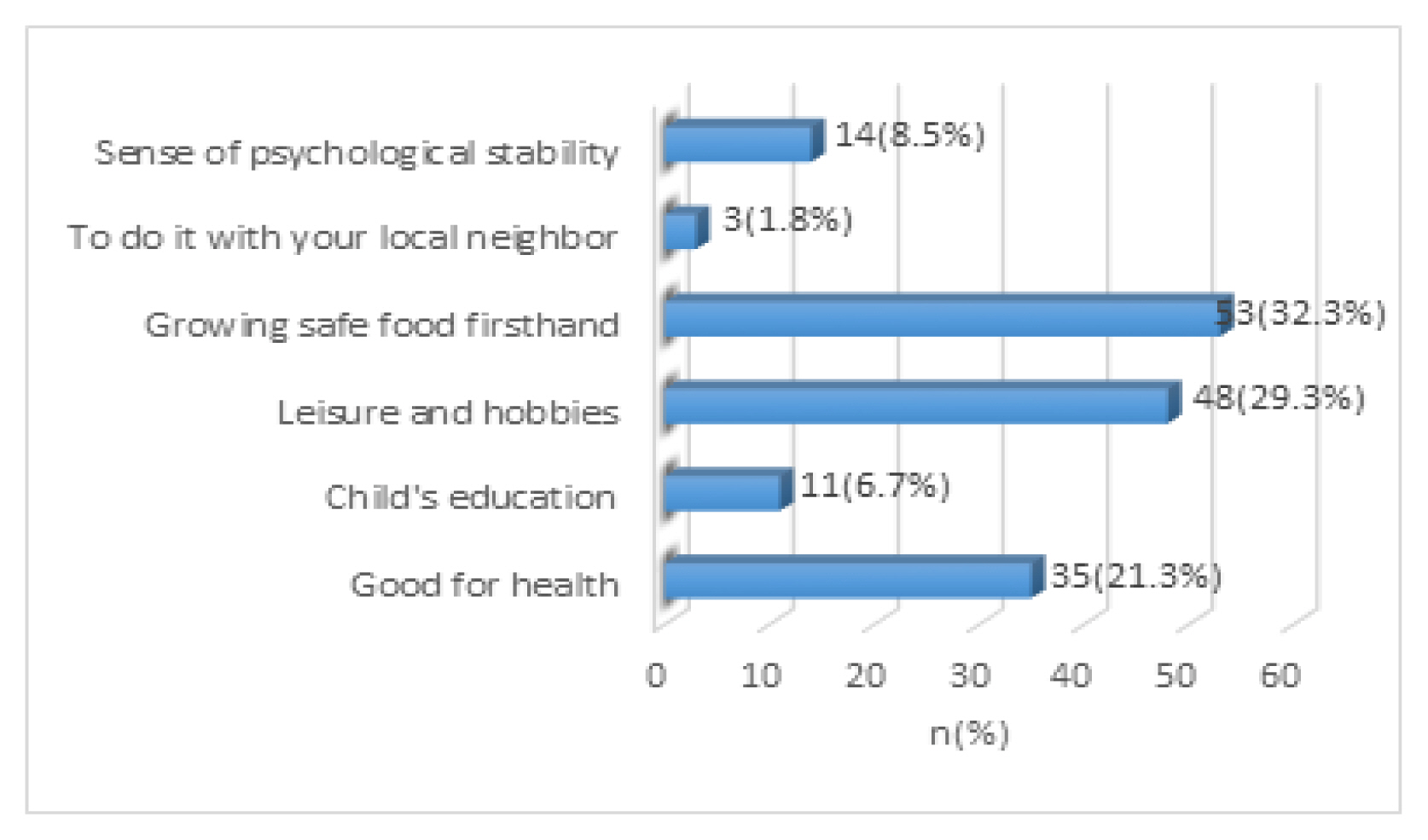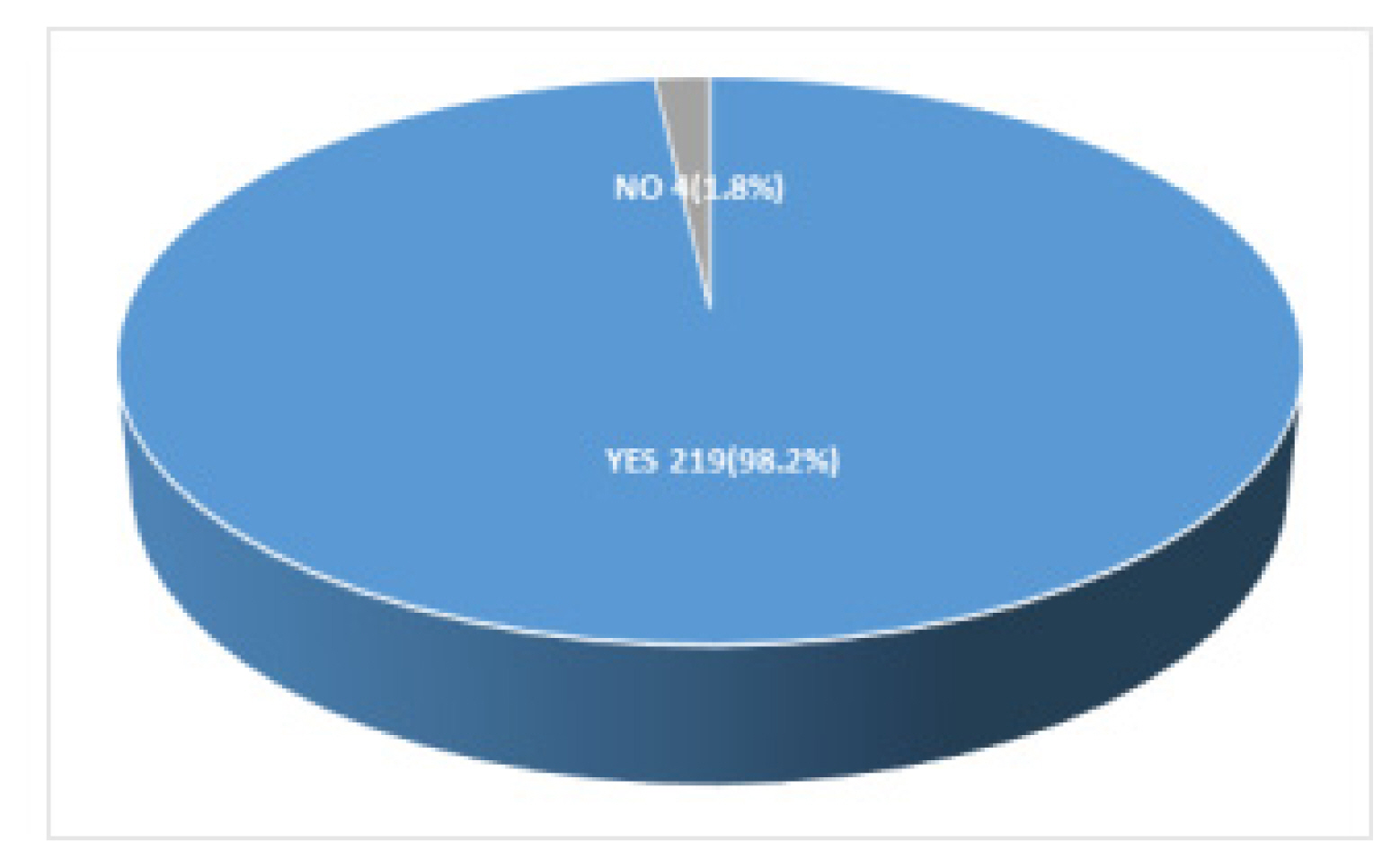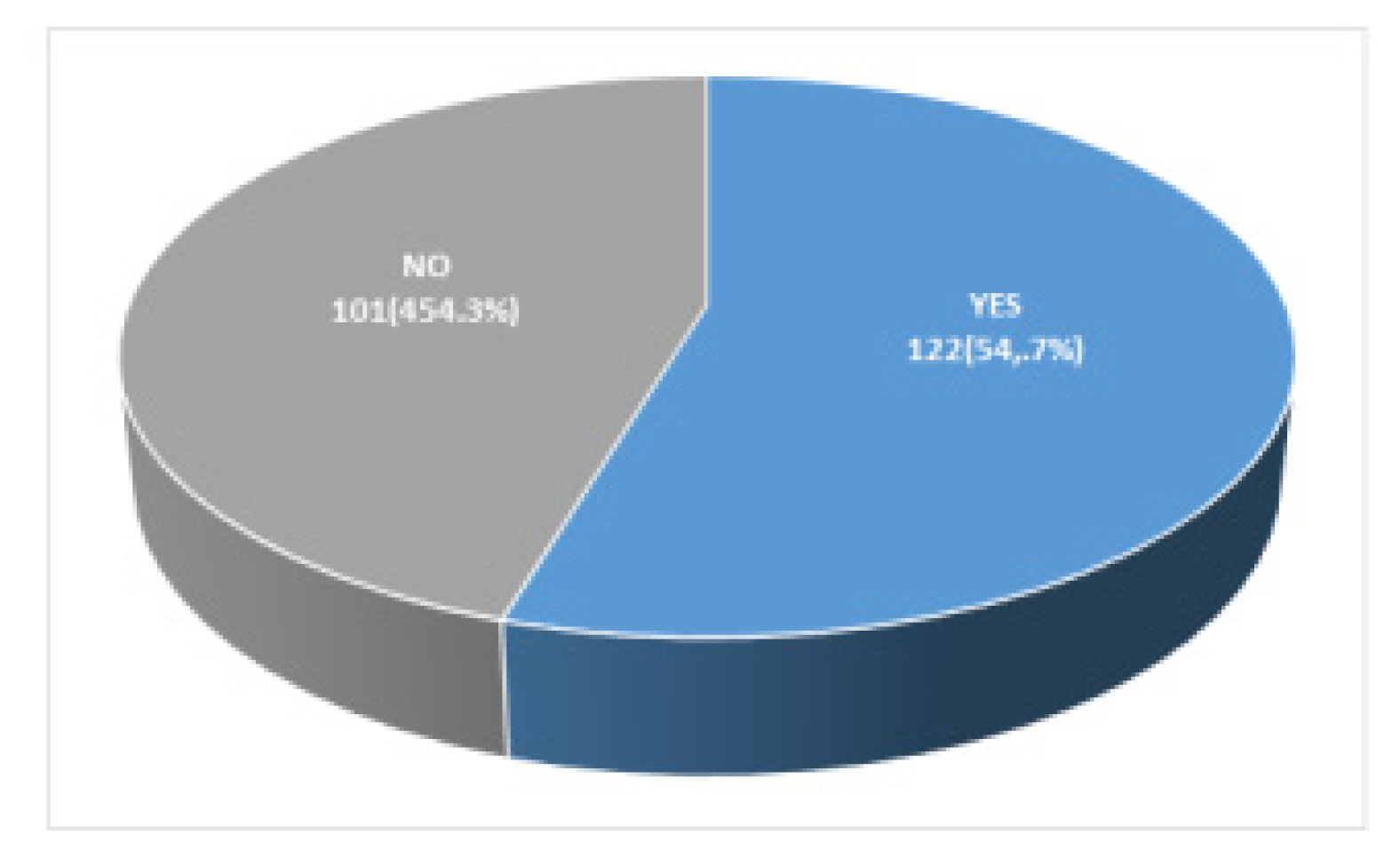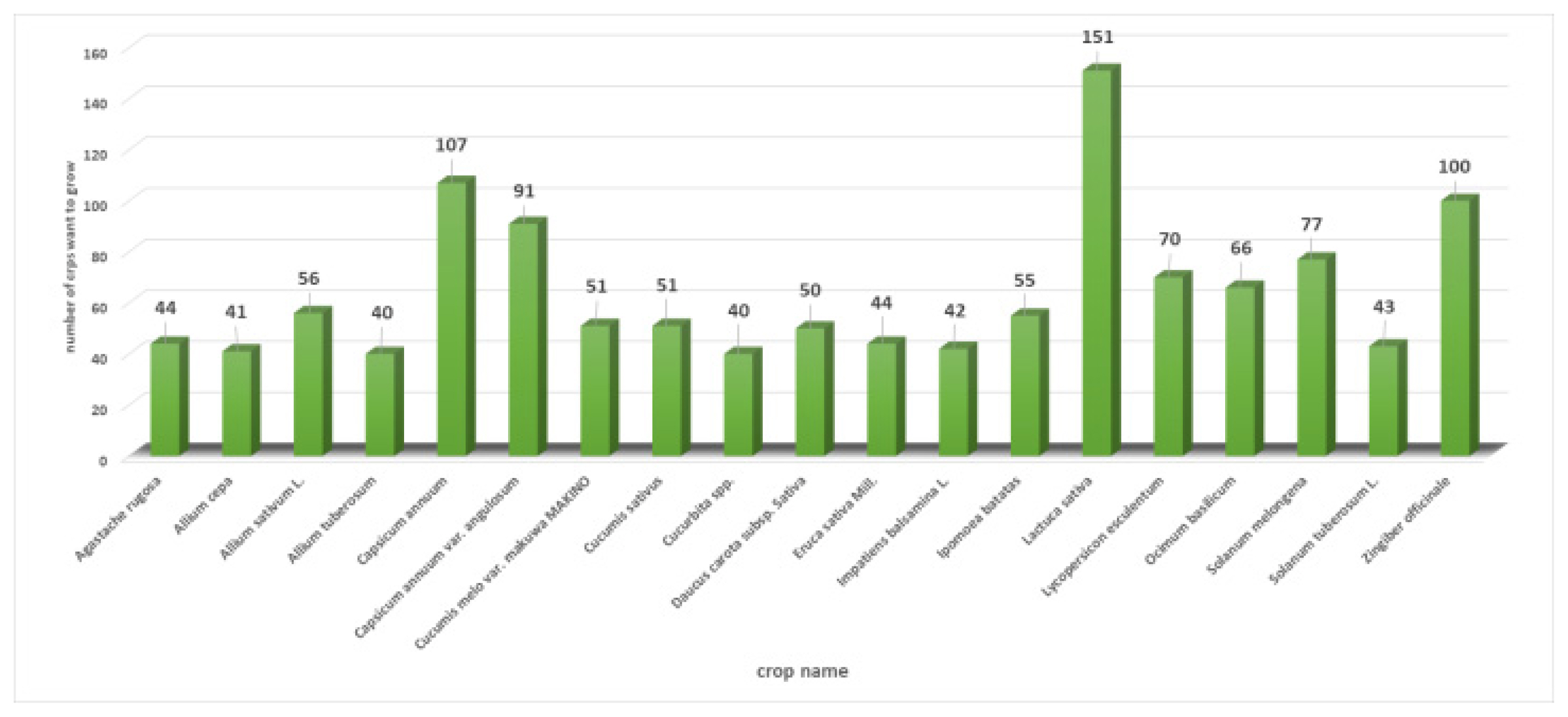 |
 |
- Search
| J. People Plants Environ > Volume 24(1); 2021 > Article |
|
ABSTRACT
Background and objective: This study was conducted as part of research to promote garden diversity and seek sustainable garden management plans, as well as to determine the trends in understanding and use of companion plants as an eco-friendly farming method and provide the results as the basic data for sustainable urban agriculture.
Methods: To determine the trends in garden activities, eco-friendly pest control, and use of companion plants, a survey was conducted on 230 urban residents participating in the Urban Agriculture Expert course. 223 copies of the questionnaire were collected excluding missing values, and IBM SPSS statistics Ver. 25 Program was used for frequency analysis, descriptive statistics, and regression analysis.
Results: Most of the respondents were female (71.3%), homemakers (26.5%), were in their 50s (29.1%), and had 2 members in the family (27.8%). 164 respondents (73.5%) had experience in gardening, most of them once a week (31.7%) and for self-consumption (55.5%). Both men and women raised crops for safe food production (32.3%), and they most preferred the city garden type (39.9%). For the preparation of nourishment for eco-friendly garden management, most respondents (60.1%) purchased fertilizers from the market. For the reason why eco-friendly pest control is necessary, all respondents except 4 of them (98.2%) responded that it is necessary тАШbecause it affects my health as I eat it (73.5%)тАЩ, indicating that they still had a high level of interest in health. Only 43.9% of the respondents said that they had heard of companion plants, 89.2% responded that companion plants were effective in eco-friendly management, and 87.4% showed the will to participate in gardening using companion plants in the future. Finally, the regression analysis confirmed that the awareness of companion plants and satisfaction with gardening activities are key variables that increase the intention to participate in gardening activities in the future.
Conclusion: Since plants require special care depending on the period and various diseases and insect pests occur, there must be continuous research on companion plants as an eco-friendly farming method. Moreover, by actively using companion plants in urban gardens with the utility value in not only eco-friendly pest control but also in helping plant growth, urban agriculture is expected to be continuously activated and promoted by increasing satisfaction in gardening activities with aesthetic landscaping and pest control.
Methods: To determine the trends in garden activities, eco-friendly pest control, and use of companion plants, a survey was conducted on 230 urban residents participating in the Urban Agriculture Expert course. 223 copies of the questionnaire were collected excluding missing values, and IBM SPSS statistics Ver. 25 Program was used for frequency analysis, descriptive statistics, and regression analysis.
Results: Most of the respondents were female (71.3%), homemakers (26.5%), were in their 50s (29.1%), and had 2 members in the family (27.8%). 164 respondents (73.5%) had experience in gardening, most of them once a week (31.7%) and for self-consumption (55.5%). Both men and women raised crops for safe food production (32.3%), and they most preferred the city garden type (39.9%). For the preparation of nourishment for eco-friendly garden management, most respondents (60.1%) purchased fertilizers from the market. For the reason why eco-friendly pest control is necessary, all respondents except 4 of them (98.2%) responded that it is necessary тАШbecause it affects my health as I eat it (73.5%)тАЩ, indicating that they still had a high level of interest in health. Only 43.9% of the respondents said that they had heard of companion plants, 89.2% responded that companion plants were effective in eco-friendly management, and 87.4% showed the will to participate in gardening using companion plants in the future. Finally, the regression analysis confirmed that the awareness of companion plants and satisfaction with gardening activities are key variables that increase the intention to participate in gardening activities in the future.
Conclusion: Since plants require special care depending on the period and various diseases and insect pests occur, there must be continuous research on companion plants as an eco-friendly farming method. Moreover, by actively using companion plants in urban gardens with the utility value in not only eco-friendly pest control but also in helping plant growth, urban agriculture is expected to be continuously activated and promoted by increasing satisfaction in gardening activities with aesthetic landscaping and pest control.
As the consumption pattern is changing with more emphasis on health worldwide, the need for safety of agricultural products and sustainable agriculture has emerged, which is rapidly increasing the demand for eco-friendly agriculture (Forschungsinstitut f├╝r Biologischen Landbau (FiBL) and International Federation of Organic Agriculture Movements(IFOAM), 2014). Moreover, as urban residents are participating more and more in urban gardening, there is a need for more functional and aesthetic forms of gardens, and there is a growing interest in planting methods that can increase use of small spaces, diversification and use of crops, production of safe foods, and eco-friendly disease and insect pest control that requires little effort (Chae et al., 2019b). As such, since the 1990s when discussions about urban agriculture first began, there has been emphasis on the public value of agriculture, urban-rural exchange, and national interest in agriculture and rural areas (Jang et al., 2012). Making publicized since 2010, there is a constant increase in the interest and demand for urban agriculture among the media, citizens, and organizations (Lee, 2013). Urban agriculture is the act of cultivating or growing crops using lands, buildings, or various living spaces in urban areas. For a long time, companion cropping (mixed cropping) or crop rotation (shift of crops) has been used to reduce damage from diseases and insect pests (Kim et al., 2013). Recently, with the gradual expansion of eco-friendly farming methods, interest in companion planting is growing once again (Ryu and Lee, 2002), and in addition to the urban farming effect, cultivation using companion plants is expanding (Shin et al., 2014).
Companion planting is one of the cropping customs that have been carried out from the past, and by planting different crops together, they help each other, or one helps the other based on the theory that a certain plant can improve or inhibit another plantтАЩs growth (Hong et al., 2020). These companion plants are known to be effective in attracting beneficial insects, absorbing nutrients, controlling pests, or providing shades or support, but the term is still unfamiliar to urban residents in Korea. However, in Africa where food is more important than anything else, organic farming is emerging as alternative agriculture to practice the тАЬGreen Revolution in AfricaтАЭ due to the financial difficulty that keeps farmers from purchasing expensive chemical fertilizers and agricultural pesticide, and thus companion plants are considered suitable for prevention of pests (Hassanali et al., 2008) and are continuously studied in many countries including the U.S. Studies in Korea on eco-friendly pest and weed control using companion plants since 2000 discovered that a greenhouse chrysanthemum farm used Solanum melongena as a trap plant and effectively attracted thrips (Kang et al., 2011). In organic aquaculture of leaf vegetables, Ocimum basilicum, Coriandrum sativum, Houttuynia cordata, Tanacetum cinerariifolium, and Mentha piperita avoided pests (Seo and Kim, 2009), and as a result of using 7 types of Brassicaceae crops such as mustard plants and leaf mustards to attract striped flea beetles, it was found that mustard plants showed the greatest attraction effect (Kim et al., 2013). As such, studies on companion plants as crops promoting plantation diversity and plant growth were mostly focused on controlling diseases and insect pests, while there are relatively insufficient studies on application to and management of urban gardens (Han et al., 2015). Therefore, this study was conducted to understand companion plants and determine the trends of use for active use of companion plants to create aesthetic landscapes with companion plants in actual urban gardens and increase satisfaction in gardening activities such as pest control, thereby providing basic data for sustainable urban agriculture.
For promotion of garden diversity and use of sustainable urban gardens, this study conducted a survey for 50 days from June 1 to July 20, 2020 on 230 urban residents participating in the Urban Agriculture Expert course in the agricultural technology centers of the Jeolla region (Gwangju, Naju, Wanju, Jeonju), the Chungcheong region (Cheonan), and part of the Seoul region (Yangcheon-gu) to determine the trend of gardening activities, eco-friendly pest control, and use of companion plants.
The survey was comprised of total 24 items: 4 items on demographic characteristics, 9 items on the basics of gardening, 4 items on creation and management of eco-friendly gardens, 6 items on understanding and use of companion plants, and freely writing about crops that the respondents want to grow (Table 1). Despite having to be contactless due to COVID-19, we described in detail the purpose and contents of the survey as well as terminology on companion plants, after which the survey was conducted in self-administered method in which the respondents in each group respond to the questionnaire after answering the questions to perceive the intent of the survey.
Out of total 230 copies of the questionnaire, 223 copies were ultimately used in the analysis except 7 copies that did not respond to all items or have many missing values. The collected data were analyzed using IBM SPSS statistics Ver. 25 after being counted and organized on Excel. Frequency analysis was conducted on demographic characteristics of the respondents, general matters of gardening activities, eco-friendly garden management, and creation of gardens using companion plants. Satisfaction with gardening activities and intention to participate were rated on a 5-point Likert scale. The respondents were to rate the items on a scale of 1 to 5, with higher scores indicating higher satisfaction and intention to participate. Regression analysis was conducted to determine the effects of two variables, companion plant terminology recognition and gardening activities, for intention to participate in gardening activities.
The characteristics of respondents are as shown in Table 2. There were 64 male (28.7%) and 159 female (71.3%) respondents, and none of them were under age 20, while many of them were in their 50s (65, 29.1%) and 60s (63, 28.2%), followed by 40s (51, 22.9%), 30s (24, 10.8%), and 20s (14, 6.3%), and the fewest were 70s or older (6, 2.7%). Most of them were homemakers (26.5%), followed by the self-employed (18.8%) > salaried employees (17.0%) > specialized professions (14.4%) > others (10.3%) > agriculture-related (8.5%) > students (4.5%). Others were those without jobs after retirement. Most of the respondents had 2 members (62, 27.8%) and 3 members (60, 26.9%) in the family, followed by 4 members (49, 22.0%), 1 member (29, 13.0%), and 5 members or more (23, 10.3%).
Regarding gardening experience, 164 respondents (73.5%) responded that they had experience, while 59 (26.5%) responded that they did not. Most of them (52, 31.7%) said they participate in gardening no more than once a week, followed by about 2тАУ3 times a week (22.0%) > almost every day (21.3%)> about 4тАУ5 times a week (14.6%) > about once a month (6.7%) > about once every other week (3.7%). This is quite different from the studies by Chae et al. (2019a), Youn (2018), and Park et al. (2016) claiming that most participated 2тАУ3 times a week (32.2%), which suggests that this frequency is related to accessibility to the garden depending on its location. Most respondents used the crops for self-consumption (91, 55.5%), followed by sharing with family and relatives (47, 28.7%), sharing with close neighbors (19, 11.6%), others (3, 1.8%), and donating to the underprivileged in the community or selling to the market or neighbors (2, 1.2% each) (Table 3), showing similar results with Chae et al. (2019a) and Park et al. (2016).
Most respondents claimed that the biggest difficulty in gardening was pest control methods (105, 64.0%), followed by management techniques by crop growth stage (43, 26.2%) > crop cultivation schedule (8, 5.0%) > others (4, 2.4%) > use of garden crops (3, 1.8%) > rude behaviors of neighboring gardens (1, 0.6%) (Fig. 1). Most responded that what they expect from gardening activities is тАЬGrowing safe food firsthandтАЭ (53, 32.3%), suggesting that they have continuous interest in health (Fig. 2).
As a result of conducting a survey with multiple dichotomy sets to determine the purpose of gardening and preferred models, it was found that the main purpose of gardening for both men and women was production of safe food (M = 8.8%, F = 23.5%, T = 32.3%). This is consistent with Chae et al. (2019a) and Park et al. (2016), suggesting that there is emphasis on the need for factors related to тАЬhealthтАЭ regarding the gardening purpose of urban residents in the last 5 years, but there was no statistically significant difference (Table 4).
As for preferred garden models, men preferred urban- rural exchange type (9.6%) and city park type (9.3%), whereas women preferred city park type (30.6%), showing some difference depending on disposition. Overall, they preferred the city park type garden model (39.9%), but the garden preference model by gender had a standard deviation of 0, and thus statistical significance could not be tested (Table 5).
Regarding how the respondents are preparing nourishment for eco-friendly garden management, most responded that they are тАШpurchasing fertilizers from the marketтАЩ (134, 60.1%), followed by purchasing fertilizers and nutrient supplements sold in the market (44, 19.7%) > water only (18, 8.1%) > using homemade compost (17, 7.6%) > getting from others in the neighborhood (9, 4.0%) > others (1, 0.5%). To prevent diseases and insect pests, most were тАШpeeling off the diseased leaf or catch with handsтАЩ (109, 48.9%), followed by purchasing and spraying agricultural pesticides (56, 25.1%), not doing pest control (46, 20.6%), and others (12, 5.4%), showing consistent results with Chae et al. (2019a). To the question of whether eco-friendly pest control is necessary, all except 4 respondents (219, 98.2%) answered that it is necessary (Fig. 3), mostly тАШbecause it affects my health as I eat itтАЩ (164, 73.5%), followed by тАШto protect various living things in natureтАЩ (36, 16.1%), тАШto prevent environmental pollutionтАЩ (21, 9.4%), and others (2, 1.0%), showing consistent results with Chae et al. (2019a). 122 respondents (54.7%) said they experienced eco-friendly pest control (Fig. 4), and as a result of presenting the same pest control methods in Chae et al. (2019a), most respondents тАШmade and sprayed egg yolk seed oilтАЩ(68, 55.8%), followed by others (26, 21.3%) > purchased and sprayed eco-friendly materials sold in the market such as neem oil (17, 21.3%) > made and sprayed plant extracts such as garlic and chili pepper seed (9, 7.4%) > Made and sprayed extracts from dried Tanacetum cinerariifolium (2, 1.6%), showing similar results with previous studies. Others included using water from boiled cinnamon bark and ripe Prunus mume made into vinegar, using EM, fermented oil cakes, pyroligneous liquor, egg yolk and vinegar, cooking oil, surfactant, alcohol, used water from washing rice, used coffee grounds, milk + makgeolli, and actually catching the pests (Table 6).
As a result of the survey on gardens using companion plants (Table 7), only 43.9% of the respondents said they have heard of companion plants (Fig. 5), which is slightly higher than the survey by Chae et al. (2019b) with 29.9% but indicating that there is still insufficient awareness of terminology. Among those aware of the term тАШcompanion plantтАЩ, only 18.8% had experience creating a garden using companion plants, 42.8% of which created the garden on an open field (weekend farm). This indicates that various effects must be promoted nationwide to actively change the awareness of companion plants. Regarding the eco-friendly management effect of companion plants, 89.2% responded that they were effective, 65.4% of which claimed that тАШdiseases and pests are reducedтАЩ. This is somewhat lower than 75.5% in the study by Chae et al. (2019a) but still shows that companion plants are effective in controlling diseases and insect pests. 87.4% of all respondents showed the will to participate in gardens using companion plants in the future (Fig. 6). Thus, more quantitative research must be conducted to determine the effects of various crops.
As a result of obtaining PearsonтАЩs R, which is the correlation coefficient of the intention to participate in gardening activities, there was a correlation between satisfaction with gardening activities and companion plant terminology recognition as shown in Table 8, thereby showing a statistically significant result. However, Kang (2016) claimed that the correlation coefficient below .39 has little relevance, and thus companion plant terminology recognition has a low correlation.
To check the variables affecting intention to participate in gardening activities, which is the dependent variable, we determined the relationship using the unstandardized coefficient (B) and standardized coefficient of multiple regression analysis, after which we conducted a t-test to find out whether the constant and regression coefficient have statistical significance (Table 9). The results showed that satisfaction with gardening activities and companion plant terminology recognition affected intention to participate in gardening activities. The variable that had the greatest effect on intention to participate in gardening activities was satisfaction with gardening activities, followed by companion plant terminology recognition, indicating that people with higher satisfaction with gardening activities had greater intention to participate in gardening activities. This result shows that companion plant terminology recognition and satisfaction with gardening activities are key variables that improve intention to participate in gardening activities.
We had 223 respondents freely write down 2 to 10 crops they most want to grow in gardens. As a result of selecting the top 20 crops based on the data, the most preferred crop was Lactuca sativa, followed by Capsicum spp., Zingiber officinale, Capsicum annuum L., Solanum melongena, Solanum lycopersicum, Ocimum basilicum, Allium sativum, Ipomoea batatas, Eruca sativa, Cucumis sativus, Cucumis melo var. makuwa, Daucus carota, Agastache rugosa, Solanum tuberosum, Impatiens balsamina, Allium cepa, Cucurbita moschata, wildflower, and Allium tuberosum. Cucurbita moschata, wildflower, and Allium tuberosum were preferred by 40 respondents and thus ranked at the bottom side by side within the top 20. This result is similar to the studies by Lee (2016) and Moon et al. (2014) on types of crops commonly examined, but unlike previous studies, this study showed that there is a growing interest in herbs and flowers aside from vegetables such as herbs, Hydrangea macrophylla, Chrysanthemum, Houttuynia cordata, Geranium, Paeonia lactiflora, Lilium, Tulipa, Tagetes erecta, and edible flowers, thereby providing quite positive results for creation of gardens using companion plants as suggested in this study (Fig. 7). In addition, there were other opinions such as berries, labiatae, and traditional flowers.
As a result of surveying the types of garden crops the respondents want to grow by gender, men most preferred vegetables (38, 17.0%), followed by medicinal crops (9, 4.0%), fruit trees and flowers (6, 2.7%), and herbs (4, 1.8%), while women most preferred vegetables (74, 33.2%), followed by herbs (34, 15.2%), flowers (27, 12.1%), medicinal crops (15, 6.7%), and fruit trees (10, 4.5%). This showed that both men and women most wanted to grow vegetables, which is similar to the study by Chae et al. (2019a). The result of analyzing the significance showed that the significance level of the chi square value 10.274 is 0.036, which is lower than 0.05 and thus has statistically significant results at the 95% confidence level. This indicates that there is a difference in preferred crops by gender; men are interested in growing healthy food, while women are interested in not only food but also creating landscape in terms of aesthetics (Table 10).
As part of research to promote garden diversity and seek sustainable garden management plans, this study was conducted to examine the understanding and use of companion plants as an eco-friendly management plan in urban gardens among urban residents participating in the Urban Agriculture Expert course operated by agricultural technology centers in the Jeolla region, the Chungcheong region, and a part of the Seoul region. The awareness of companion plants among urban residents is as follows.
First, 164 respondents (73.5%) answered that they have experience in gardening, most of them once a week (31.7%) and for self-consumption (55.5%). Both men and women raised crops to produce safe food (32.3%), and their most preferred garden type was the city garden type (39.9%).
Second, to prepare nourishment for eco-friendly garden management, most respondents said they тАШpurchase fertilizer from the market (60.1%)тАЩ. To prevent diseases and insect pests, they claimed that they тАШpeel off the diseased leaf or catch with hands (48.9%)тАЩ. For the reason why eco-friendly pest control is necessary, all respondents except 4 of them (219, 98.2%) responded that it is necessary тАШbecause it affects my health as I eat it (73.5%)тАЩ, indicating that they still had a high level of interest in health. 54.7% responded that they had experience in eco-friendly pest control, and most of them тАШmade and sprayed egg yolk seed oil (55.8%)тАЩ for pest control.
Third, only 43.9% of the respondents claimed they have heard of companion plants, 18.8% of which said they have gardened in an open field using companion plants (42.8%). 89.2% responded that companion plants are effective in eco-friendly management, and 87.4% said they intend to participate in gardening using companion plants in the future. Finally, as a result of testing the hypotheses set in this study with multiple regression analysis, it was found that satisfaction with gardening activities and companion plant terminology recognition were variables affecting the dependent variable, which is intention to participate in gardening activities.
Fourth, the crops that the respondents want to grow the most were not only vegetables such as Lactuca sativa, Capsicum spp., Zingiber officinale, and Capsicum annuum L., but also herbs and flowers such as Ocimum basilicum, Agastache rugosa, Impatiens balsamina, and wildflowers. Since plants require separate management in each time period and various diseases and insect pests occur, it is necessary to continuously conduct research on companion plants with high utility value that help plant growth in addition to eco-friendly pest control.
This study is an initial research on use of companion plants for eco-friendly operation and management of urban gardens, and its limitation is that the survey could not be conducted on urban residents nationwide due to COVID-19. Nonetheless, the results will have high utility value as the basic data for continuous garden management and aesthetic landscaping as this study determined the trend of actual urban garden users. Based on the contents of this study, further research can seek operation of urban agriculture and improvement of user satisfaction by drawing quantitative data that can guarantee sustainability of urban gardens. This is expected to be actively used in establishing measures for desirable garden management and maintenance plans, thereby continuously activating the use of urban agriculture.
Table┬а1
Organization of survey items
| Survey No. | Contents | No. of Item | Reference |
|---|---|---|---|
| DV1 ~ DV4 | The respondentтАЩs demographic characteristics | 4 | - |
| V1 ~ V9 | Basic gardening | 9 | Youn(2018), Part et al., (2016) |
| V10 ~ V13 | Creation and management of eco-friendly gardens | 4 | RDA(2004), Kim et al., (2013) |
| V14 ~ 20 | Garden cultivation using companion plants | 7 | Part et al.(2016), Chae et al., (2019a) |
Table┬а2
The respondentтАЩs demographic characteristics
Table┬а3
The percentage of general items about gardening
Table┬а4
Main purpose of gardening by gender(*duplicate selection possible)
| Item | Male | Female | Total | t | df | p | |
|---|---|---|---|---|---|---|---|
| Main purpose of gardening | Safe food (production type) | 24( 8.8) | 64( 23.5) | 88( 32.3) | тИТ1.000 | 56.000 | .322NS |
| Hobbies & leisure activities | 20( 7.4) | 56( 20.6) | 76( 28.0) | ||||
| Promotion of physical & mental health | 20( 7.4) | 38( 13.9) | 58( 21.3) | ||||
| Promotion of exchange and friendship with neighbors | 5( 1.9) | 12( 4.4) | 17( 6.3) | ||||
| Child education and learning | 4( 1.5) | 23( 8.4) | 27( 9.9) | ||||
| Others | 2( 0.7) | 4( 1.5) | 6( 2.2) | ||||
|
|
|||||||
| Total | 75( 27.7) | 197(72.3) | 272(100.0) | ||||
Table┬а5
Preference type of gardening by gender(*duplicate selection possible)
Table┬а6
Survey about eco-friendly garden management
Table┬а7
Recognition survey about companion plants
Table┬а8
Correlation between participation in future gardening
| Itemy | A | B | C |
|---|---|---|---|
| A | 1.000 | ||
| B | тИТ.252*** | 1.000 | |
| C | .432*** | тИТ.119NS | 1.000 |
Table┬а9
Multiple regression analysis for participation in future gardening
Table┬а10
Type of garden crop preference
| unit: n(%) | |||||||
|---|---|---|---|---|---|---|---|
|
|
|||||||
| Vegetable | Fruit tree | Medicinal crops | Flower | Herb | Total | ||
| Male | 38( 17.0) | 6( 2.7) | 9( 4.0) | 6( 2.7) | 4( 1.8) | 63( 28.3) |
x2 = 10.274 df = 4 p = .036* |
| Female | 74( 33.2) | 10( 4.5) | 15( 6.7) | 27( 12.1) | 34( 15.2) | 160( 71.7) | |
|
|
|||||||
| Total | 112( 50.2) | 16( 7.2) | 24( 10.7) | 33( 14.8) | 38( 17.0) | 223(100.0) | |
References
Chae, Y, IK Hong, SM Lee, YB Jung, KS, BK Lee. 2019a. A survey on usersтАЩ perception on the management of eco-friendly urban garden using companion plants. J People Plants Environ. 22(Suppl II):158.
Chae, Y, IK Hong, SM Lee, YB Jung, KS Han, YA Jang, SH Youk. 2019b. Effects of mixed cultivation of companion plant in urban garden on the pest development and growth of cabbages. Hortic Sci Technol. 37(Suppl I):75-76.
Forschungsinstitut f├╝r Biologischen Landbau(FiBL) and International Federation of Organic Agriculture Movements (IFOAM)2014. The world of organic agriculture: statistics and emerging trends Frick, Switzerland: Organic eprints.
Han, EJ, JP Choi, YK Kim, SJ Hong, JH Park, CK Shim, MJ Kim, SC Kim. 2015. Suppressive effect of repellent plant cultivation against striped flea beetle of chinese cabbage. Korean J Org Agric. 23(4):911-921.

Hassnali, A, H Harren, ZR Khan, JA Pickett, CM Woodcock. 2008. Intergrated pest management: the push-pull approach for controlling insect pests and weeds of cereals, and its potential for other agricultural systems including animal husbandry. Philos Trans R Soc Lond B Biol Sci. 363(1491):611-621. https://doi.org/10.1098/rstb.2007.2173


Hong, IK, HK Yun, YB Jung, SM Lee, BK Lee. 2020. Classification of crops by type of companion plant. J People Plants Environ. 23(Supplement I):11.
Jang, BG, YJ Choi, CC Cho. 2012. A study on assessment of urban agriculture education program: Focused on urban agriculture instructor course at Gyeonggi Provincial Agricultural Research & Extension Services. J Agric Ext Community Dev. 19(2):273-299.

Kang, JH 2016. Using statistical analysis according to the new spss program Seoul, Korea: Crownbook Press.
Kang, TJ, YS Choi, IS Hwang, HJ Kim, GR Choi. 2011. Attractant effect of trap plant and natural enemy on biological control of frankneiela occidentalis in PVC chrysanthemum house. Korean Soc Appl Entomol Suppl II. 157.
Kim, MJ, CK Shim, YK Kim, HJ Jee, JC Yun, JH Park, EJ Han, SJ Hong. 2013. Effect of inter-and mixed cropping with attractant and repellent plants on occurrence of major insect pests in organic cultivation of Chinese cabbage. Korean J Org Agric. 21(4):685-699.

Lee, BG 2016. The characteristics of kitchen garden of urban agriculture in Busan. MasterтАЩs thesis. Kyungsang University, Busan, Korea.
Lee, DG 2013. A study of the preference on the type of urban agriculture and activity preferences by lifestyle. MasterтАЩs thesis. Hanyang University, Seoul, South Korea.
Moon, JH, SM Lee, SJ Jeong, AK Kim, JJ Choi, KN Gim, DG Park. 2014. Preference of crop species of allotment gardeners. Korean J Hortic Sci Technol. 32(Suppl II):64.
Park, EH, KS Yoo, YN Han, EH Jang, SJ Jeong, DK Park. 2016. Utilization analysis on participants of functional vegetabel garden model for urban agriculture. J Korean Soc People Plants Environ. 19(5):393-401. http://dx.doi.org/10.11628/ksppe.2016.19.5.393

Rural Development Adminstration2004. Practice of eco-friendly agricultural methods for horticultural crops Suwon, Korea: RDA.
Ryu, MI, JH Lee. 2002. Population ecology Seoul: Seoul National University Press.
Seo, SY, YG Kim. 2009. Two entomopathogenic bacteria, Xenorhabdus nematophila K1 and Photorhabdus temperata subsptemperata ANU101 secrete factors enhancing Bt pathogenicity against the diamondback moth, Phutella xylostella. Kor J Appl Entomol. 38:385-392. https://doi.org/10.5656/KSAE.2009.48.3.385

Shin, YS, HN Yoo, SH Jeong, YH Yun, JH Joo. 2014. Environmentally friendly urban a riculture using public plants in roof greening. Korean Environ Sci Soc. 23(Suppl):741-743.
- TOOLS
-
METRICS

-
- 4 Crossref
- 2,015 View
- 58 Download
- Related articles in J. People Plants Environ.












